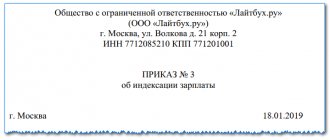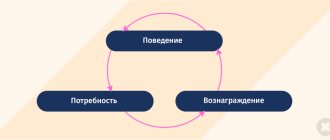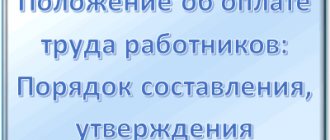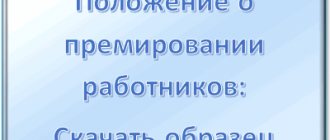Any company is, first of all, people who work for its benefit. The prosperity of an organization and its decline will directly depend on its employees. That is why today many employers are interested in motivating staff. Special systems are being developed for implementation at the enterprise, documents are being prepared, etc. All these actions are aimed at achieving a single goal - encouraging the effective performance of employees.
Dear readers! The article talks about typical ways to resolve legal issues, but each case is individual. If you want to find out how to solve your particular problem , contact a consultant:
8 (800) 700 95 53
APPLICATIONS AND CALLS ARE ACCEPTED 24/7 and 7 days a week.
It's fast and FREE !
Personnel motivation is the most important tool that allows you not only to manage human resources, but also, ultimately, to confidently compete in a specific struggle in your market. In times of crisis, the established system allows us to obtain excellent results at minimal cost.
Issues of motivation are not regulated by legislation. All points are determined in local documents valid within the same enterprise. One of these acts is the provision on personnel motivation.
What kind of document is this?
The regulation on staff motivation is a local act that is developed by the employer.
In the Labor Code of the Russian Federation, Art. 8. The regulation is adopted in order to increase the efficiency of departments, groups of workers and each employee in particular.
Labor Code of the Russian Federation
With the implementation of this document, the employer abandons the idea that additional funding for staff work is a cost. Instead, an understanding comes that motivation, including material motivation, is an investment.
This provision may stipulate not only bonuses and other monetary rewards, but also non-material incentives. According to research by experts, the latter are no less effective.
Before formalizing the regulation, it is necessary to carry out preparatory work, including collecting information and documents about the company itself, its employees, the incentive measures that are currently in effect, analyze this data and create a document based on it. This is painstaking work that will create a truly effective position.
Objectives and reasons for compiling
Why draw up a position? The employer can work without it.
The law does not establish the obligation to create such a document. However, it is the employer who is primarily interested in developing and implementing this system within the soybean enterprise.
This is due to the fact that the provision solves the following problems:
- improving the quality of work of staff in general and each employee in particular;
- introduction of a flexible system of material incentives, which allows reducing costs by rewarding employees who really showed the best results;
- increasing the efficiency of control and accounting when planning activities and performing individual tasks;
- stimulating employee initiative;
- unlocking the potential of individual personnel;
- integration in the system of structural units, thanks to the creation of groups (councils, commissions, etc.);
- attracting managers of different levels to set effective goals and objectives for employees.
When should an employer consider developing such a provision:
- low labor efficiency;
- a bonus system that is incomprehensible to employees;
- no relationship between the performance of a particular employee and the size of his bonus;
- “equalization” in wages.
The theories of personnel motivation that form the basis of modern methods are in our article.
Is compensation provided for early dismissal during layoffs? Find out .
What are the employee incentive measures?
To increase labor discipline and production indicators, various organizations often practice comprehensive measures of incentives for work and punishments for shoddy work. If we rely on the Labor Code of the Russian Federation, in particular Article 191, on the part of the employer, incentives for employees can be expressed in the following:
- appointment of a bonus;
- formal thanks;
- donation of a valuable item;
- highlighting the employee as the best in the team;
- issuance of a certificate.
Also see “Types of bonuses and rewards: making a choice.”
How to draw up a regulation on staff motivation?
Issues of staff motivation can be framed in different ways.
For example, some employers stipulate them in the collective agreement in the form of a separate section, others - in the form of a chapter in the regulations on wages (if we are talking about material incentive measures). The best option is a separate document.
Depending on the design method chosen by the employer, the procedure for developing a section or document on motivation is determined.
For example, if these issues are covered in a collective agreement, then additions will be made to it in the manner prescribed by this act. At the same time, there may be an obligation to involve the workforce in considering the inclusion of such provisions in the contract. This preparation may not be very convenient for the employer himself.
That is why most of them draw up a separate provision on personnel incentives. The employer will decide what exactly to include in this document. The law does not provide for any specific rules for its formation.
Sections
Current practice demonstrates that most often the following sections are included in the staff motivation regulations:
- general provisions (goals and objectives, as well as basic principles of personnel motivation);
- forms and sizes of material motivation;
- non-material motivation of personnel;
- management competence
- final provisions.
So, like other documents, the provision begins with general questions.
Typically they contain the following information:
- scope of the document;
- what kind of simulation measures are taken (material, intangible or complex);
- the principle of individual employee incentives;
- the purpose of adopting the provision;
- tasks of developing a special motivation system;
- terminology, decoding of such concepts as “motivation system”, “material motivation”, “incentives”, etc.
Then the types of incentives themselves and the cases when they are provided to employees are prescribed.
The section “management competence” indicates the persons who can make decisions about rewarding employees. Typically, this is the CEO. But the basis for the incentive is a memo, which is drawn up by the employee’s immediate supervisor.
The final provisions indicate the effective date of the document and other information.
Why do you need a staff motivation questionnaire? Read our article.
You will find general labor protection requirements at work.
What is included in the average salary calculation? Find out .
Compilation rules
The law does not stipulate uniform rules for drafting regulations. The specifics of the adoption of this act can be determined in the collective agreement. They operate within the framework of one enterprise and are mandatory for it.
The position is drawn up in writing. To put it into effect, the head of the enterprise issues an order.
What exactly to indicate in the text of the regulation itself is up to the employer to decide.
It should be taken into account that when a local document contains norms that worsen the employee’s situation in comparison with what is defined in the Labor Code of the Russian Federation, they are declared invalid. The same applies to cases where the provision is contrary to current legislation.
Who is developing?
Developing regulations is the task of the manager.
Usually he entrusts its creation to employees of the personnel department, payroll department, etc. Many companies offer services for the formation of a motivation system for enterprises, which, among other things, provides for the development of such a provision.
Sample document 2019
The regulation on employee motivation includes the sections that we reviewed earlier. The main block is “types of incentives”.
At its discretion, the employer can only use material remuneration - bonuses, bonuses. Indirect material motivation can also be used - the provision of a mobile phone, a personal car, a personal laptop, subsidies for training, etc.
You should not completely abandon non-material rewards, including awards with certificates and letters of gratitude, publications on the corporate website, etc.
Example document:
Regulations on personnel motivation
Order of entry into force
Like other local acts, the provision is put into effect by order of the head of the enterprise.
It also identifies the persons who are responsible for its implementation. From the moment the order is issued, the provision is considered to have come into force, unless otherwise specified in it.
Example of an order:
Order on the entry into force of the Motivation Regulations
How much and where is it stored?
In accordance with the legislation of the Russian Federation, documents must be stored at the enterprise for a certain time after they have lost their force. In accordance with Order of the Ministry of Culture No. 558 of 2010, the retention period for motivation provisions is 5 years (clause 575).
Order of the Ministry of Culture of the Russian Federation of August 25, 2010 N 558
As for the question of where exactly the original document will be located, it is usually transferred to the persons responsible for implementing the manager’s order. Copies can be stored in all structural divisions.
Registration process
The order for bonuses for employees is usually drawn up by a specialist from the human resources department , heads of departments or a secretary. But in any case, the signature of the director of the company is required. The entire registration process occurs in several stages:
- compiling a list of employees who need to be rewarded;
- checking all conditions for the promotion;
- adjustment of a previously compiled list of employees;
- agreeing on the amount of payment for each employee;
- submission of the final list for approval by the head of the organization.
Important ! An order to reward an employee can be written by hand or printed on a computer, but it must be signed by the head of the organization.
By law, bonuses must be issued in the form T-11 (single) or T-11a (mass). Despite the approved form, many organizations simplify this bureaucratic moment and draw up a collective agreement.
An employee incentive document is used in organizations of all types, except budget ones.
This is interesting! Federal Employment Law: Unemployment and Employment Act
Financial incentives
The Labor Code of the Russian Federation is the main document regulating material incentives for personnel. In particular, Article 191 of the Labor Code of the Russian Federation delegates the right to resolve these issues to the employer himself.
Art. talks about how this is done in practice. 8 of the same Labor Code of the Russian Federation. In particular, it is proposed to regulate the issues of incentives by local regulations. The main and recommended corporate document is the collective agreement. It should specify the conditions, amount and procedure for bonuses to staff.
The right tool for material motivation is money
The incentive system develops a special provision on bonuses and motivation of employees. The development of regulations on employee incentives is carried out by the company’s personnel or legal department. In accordance with Art. 135 of the Labor Code of the Russian Federation, during this process the opinion of the representative body of the labor collective must be taken into account. The main requirement for a document is its compliance with the law. The name and structure of the provision on financial incentives are not regulated by any rules. All materials and developments on this issue are far from perfect and are advisory in nature.
You can read more about the development of a staff motivation system on our website: https://ipshnik.com/rabota-s-kadrami/sistema-motivatsii-personala.html
In some companies, bonus issues have spontaneous and sometimes even emotional overtones and are not regulated in any way. Such companies should remember that the accrual of bonuses not specified in the governing documents may be considered controversial and therefore at any time protested by dissatisfied employees (Article 381, Article 395 of the Labor Code of the Russian Federation). That is why it makes sense to develop a corporate document regulating material incentives for personnel. An approximate structure of such a position is shown in the figure.
Approximate structure of the provision on financial incentives
Bonus algorithms
When drawing up corporate regulations on bonuses, it should be taken into account that bonuses are of two types:
- Periodic payments based on the performance of the team.
- One-time bonuses for achievements in work.
If periodic payments are a collective form of incentives, then a one-time bonus is rather individual in nature. In the process of developing local regulations, it is necessary to take into account the principles of incentives:
- The amount of remuneration should be proportional to the employee’s qualifications. The concept of qualification is defined by Federal Law No. 236 of December 3, 2012 and the established procedure for its application (Article 195 of Law 122-FZ of May 2, 2015). For budgetary organizations, the employee’s bonus depends on the tariff schedule (Resolution No. 32 of November 11, 1992). The amount of payments is not limited by law.
- Bonuses can be given based on the company's performance for the year, quarter, month, etc. The list of bonuses includes employees whose labor efficiency directly affects the results of the entire team.
- When determining the basis for bonuses, it is recommended to reward professionalism in all its manifestations. For example, with piecework wages, you can take into account the quality of work, and with time-based wages, you can take into account the volume of completed tasks.
- With regular bonuses, the main condition is often the absence of outstanding disciplinary sanctions against the employee. Although the legality of this point is controversial.
- The size of bonuses can be set either as a fixed amount or as a percentage of the main part of the salary.
- The calculation of the premium should be carried out as transparently as possible.
One-time bonuses can be paid:
- for labor rationalization and innovation;
- increase in labor productivity;
- professional development;
- for holidays and anniversaries, etc.
A bonus is an encouragement. It may be paid, but is not mandatory, unless otherwise stated in the collective agreement.
The bonus regulations of some companies specify the maximum amount of bonuses
Is it legal to deprive employees of bonuses?
There is a concept of “depreciation”. From a legal point of view, the term is not entirely correct, since in accordance with the Labor Code of the Russian Federation it is impossible to deprive an employee of a bonus for violating labor discipline. Article 192 of the Labor Code of the Russian Federation does not provide for this type of punishment. In practice, record keeping is often checked by accountants, not lawyers. Therefore, the question of the legality of such penalties is not urgent.
Often, employers who want to reduce their costs for paying bonuses actively implement a system of fines in the company. Some particularly zealous employers even manage to stipulate them in the collective agreement, which is completely illegal.
An employee can be deprived of a bonus only for serious disciplinary offenses, for example, absenteeism, deliberate damage to equipment, or appearing at the workplace in a state of drug or alcohol intoxication. The corresponding decision is formalized by order of the head.
Extract from the order on depreciation of the employee
Taxation of bonuses
Bonuses accrued and paid to employees are subject to taxation in accordance with Art. 255 clause 2 of the Tax Code of the Russian Federation. Personal income tax in 2021 is 13%. The amounts of withheld tax are reflected in the personal income tax certificate-2, which is issued to each employee upon request.
Premiums accrued at the expense of special-purpose funds or a targeted program may not be taxed (Article 270, paragraph 22 of the Tax Code of the Russian Federation).
The calculation of bonuses based on monthly work results can be considered using a simple example. The employee receives a fixed salary of 35 thousand rubles. The order provides for a bonus of 10%. The calculation scheme is simple:
- The bonus is: 35,000 * 0.1 = 3,500 rubles.
- Total accrued for the month: 35,000 + 3,500 = 38,500 rubles.
- Personal income tax: 38,500 * 0.13 = 5,005 rubles.
- Total payable: 38,500 – 5,005 = 33,495 rubles.
Any employee can perform this calculation for themselves.
A properly designed incentive program implies transparent calculation of bonuses and their regular payment.
Complaints regarding non-payment of bonuses are considered by the labor dispute commission, or through a lawsuit in court. The court will take into account labor legislation and approved local documents. Controversial issues not covered by the collective agreement may be interpreted in favor of the employee. Late payment of a bonus is equivalent to a delay in wages, which entails liability for the management of the enterprise. And in accordance with Article 237 of the Labor Code of the Russian Federation, the court may apply compensation for moral damage.
Bonus payments should not be the reason for the loss of the enterprise. Otherwise, during a tax audit, the premium amounts will be considered unjustified.
Order on bonuses
The basis for issuing a bonus to employees is an order for the enterprise, which defines the circle of persons indicating the basis for the bonus and the amounts to be paid. If the bonus procedure is not regulated by the company’s local documents, then the order is drawn up based on the representation of the heads of departments.
The form of such an order is regulated by Resolution of the State Statistics Committee No. 1 of January 5, 2004. In the case of individual bonuses, the order is drawn up in form No. T-11, and in the case of collective bonuses, T-11-a. The bonus order is entered into the employee’s personal card (form T-2).
The form for filling out an employee bonus order is standard
You can download the current 2021 bonus order forms in form T-11 and T-11-a using the current links.
Who signs
Often, persons performing management functions at the enterprise have the authority to sign the documents in question. It is worth pointing out that local acts of the company may stipulate otherwise. Other officials will be able to sign the bonus order if this is reflected in the documents. In particular, these are deputies or heads of structural divisions of the company. Provided that the manager is not on site.
Situations rarely arise that employees do not know about accrued bonuses. A person needs to familiarize himself with the act reflecting the payment of bonuses. Therefore, everyone about whom information is included in the bonus order must put their signature on it. This implies acceptance of the payments.
Regulations on material motivation
As part of corporate policy, as a local document for internal use, the company can develop a general regulation on motivation. This document is subject to the requirements of Art. 8 Labor Code of the Russian Federation. The incentive clause must be consistent with the collective agreement. As a rule, the document is drawn up in large companies with a complex structure. It is intended mainly for managers who directly implement the policy of material incentives in practice.
The document consists of two sections: bonuses and non-material motivation. In the following there is a classification and description of the conditions for using various types of incentives. The diagram given at the beginning of the article can be taken as a basis. Blindly copying a document developed for another company is not guaranteed to improve employee performance. In matters of stimulation and motivation of work, the main role is played by an integrated approach to the use of known methods, taking into account the specifics of the enterprise.
How to motivate sales employees? We talk about all the methods here: https://ipshnik.com/rabota-s-kadrami/kak-motivirovat-sotrudnikov-na-prodazhi.html
The development of standards for large businesses is usually carried out by specialized companies. The documents themselves are often multi-level. The system of rewards and penalties itself is also multi-level.
A simple layout for developing a regulation on employee motivation is presented in attached file No. 1.
Approximate structure of the Regulations on material motivation
Incentive procedure
The type of remuneration in question is drawn up in the form of an order to reward the employee on form T-11 (approved by Resolution of the State Statistics Committee of Russia dated January 5, 2004 No. 1).
The basis for the publication of this document is:
- title business paper;
- reports on the employee's work done.
Another criterion may be a memorandum of encouragement for the employee, a sample of which is prepared in free form. Typically, these documents come from the immediate supervisor assigned to the employee.
Thus, an order to reward for good work is most often drawn up in a special form provided for by the legislation of the Russian Federation. If for one employee, then the T-11 form is valid, and for several at once - T-11a.
Persons to whom it is decided to apply incentive measures must be familiarized, against signature, with a sample order to encourage an employee drawn up in their address.
In addition, this document becomes the basis for making a note in the work book, which should be done in a timely manner - no later than 7 calendar days. Moreover, the entry in it must fully correspond to the text in the order. Additionally, information about the incentive is entered into the employee’s personal file.
Further, following the link from our website, you can find a free current sample of an incentive order.
This document should mention:
- full initials of the employee – last name, first name and patronymic;
- his personnel number;
- job title;
- the department in which he works;
- reasons for incentives - success in sales, birthday, etc.;
- the selected type of incentive - gratitude, certificate, gift or bonus amount.
Below is a completed sample order for incentives for an accounting employee for the 1st half of 2021:
Read also
07.01.2019
Non-material motivation
In form and methods, non-material motivation is an extensive system of influencing employees in order to increase the efficiency of their work. Many monographs and dissertations have been written on this topic. But it is very difficult to provide for all possible options for using non-material incentives and motivation for employees of a particular company. Nevertheless, experienced managers strongly recommend that you take care of creating a provision on non-material motivation and scrupulously implement its principles.
You can read about the types of non-material incentives for company employees, as well as successful examples of their use here: https://ipshnik.com/rabota-s-kadrami/nematerialnaya-motivatsiya-sotrudnikov-primeryi.html
To develop the document, it is useful to familiarize yourself with the principles of non-financial motivation - this most powerful tool for team management - and choose the most effective methods of rewarding employees. Some of them are shown in the diagram below.
Successful implementation of a system of non-material motivation of personnel is the key to increasing labor productivity and increasing company profits
The provision on non-material motivation is necessary to consolidate a clear understanding by employees of the possible benefits and incentives that can be received as a result of their work. The creation of the situation is carried out by:
- company managers;
- lawyers;
- psychologists;
- HR specialists.
It is customary to distinguish the following factors, types and methods of non-material motivation:
- Psychological, which includes persuasion and influence on emotions.
- Social, based on publicity and creating a positive image of the campaign employee.
- Moral, oriented towards a sense of duty.
- Organizational, including the organization of good conditions for work and rest.
- Disciplinary and status.
For the coordinated work of the team, both material and non-material motivation is necessary.
The provision on non-material incentives for employees is a rather rare document in the practice of corporate organizations. Modern leaders pay undeservedly little attention to this issue. Although Art. 8 of the Labor Code of the Russian Federation and provides for the possibility of creating a local document on the procedure for non-material motivation of employees. But in most companies, these issues are included in the collective agreement or in a general document on the principles of rewards and punishments.
The algorithm for using non-material incentives can be seen in attached file No. 2.
Legal aspects of the motivation provision
The provisions on material and non-material motivation are drawn up individually and are a local act at the enterprise, which has no restrictions on the specific application. Such a document cannot be verified by regulatory authorities, and the accrual of bonuses must be carried out within the framework of current regulations and accounting rules. The regulations are drawn up in any form with the obligatory signature and seal of the director of the enterprise. The document does not require any special regulations, standards or precautions in terms of storage.
The possibility of local regulation of employee incentive methods should not be neglected. Success, as a rule, is achieved by those companies that demonstrate and comprehensively use all methods and types of motivation and their employees.
Memo for the award
It is important to understand that the payment of the premium must have a basis. In this case, it is necessary to distinguish between regular and one-time bonus payments. In the first case, as a rule, the grounds are provided by a collective agreement or internal regulations adopted by the enterprise.
The legislation does not regulate a specific form of the document, which in the future will be the basis for payment of the premium. However, this document must contain the following information:
- it is necessary to provide objective indicators that are the basis for receiving a specific type of bonus;
- the wording is given, which indicates exactly what the reward is for;
- registration of the document must be carried out on the basis of current regulatory documents.
If such a memo is written with violations, then in the future, during an audit, this may become the basis for the conclusion that the payment of the bonus was illegal.
Regulations on bonuses and material incentives for employees
Modern methods of labor productivity management use motivation and stimulation of workers. Qualified personnel committed to the company form the basis of an organization's competitiveness. The location, respect, trust, and efficiency of employees are formed by a clear and effective employee reward policy. The employer, who provided for the principles of moral and material reward in the collective agreement, internal regulations and orders, took real steps towards high staff productivity.
Documenting the principles of employee incentives allows you to:
- tie bonuses and financial incentives to the results of the employee and the company;
- increase labor costs;
- reduce income tax;
- nullify questions from inspection bodies regarding payment of sick leave;
- provide bonus indicators;
- reduce the scope of the employment contract and do not describe incentive aspects for each employee
The head of the company has the right to entrust the development of regulations on bonuses and material incentives for employees (Regulations) to the personnel service. Labor economists, accounting, and the legal department, as a rule, take part in drawing up the internal act of the organization.
It is necessary to involve the heads of all interested departments in drawing up regulations on employee incentives
Algorithm and bonus options
The employer uses labor legislation regarding bonus payments, taking into account the specifics of the structure, production and technological processes of the company. Encouraging employees is the right of management and owners. Profit and other sources of financing are the basis of incentive payments. Material reward brings joy and satisfaction to the employee. A positive attitude creates a desire to work harder.
The bonus algorithm is outlined in the Regulations, which contains:
- specific bonus parameters. For example, it is appropriate to reward a cleaner for the order in the premises, and not for conscientious work;
- the amount of payments in rubles or as a percentage of the salary;
- timing of payment of incentives;
- procedure for evaluating performance results;
- conditions for calculating the bonus.
The provision provides several grounds for the payment of bonuses.
Table: types of bonuses at the enterprise
| Bonus options | Bonus grounds |
| One-time bonus | For saving materials, for a holiday or anniversary |
| Remuneration based on performance results | For a quarter, half a year, for a year |
| Incentive payments or allowances | For combining professions, substitution, advanced training, obtaining additional education, having an academic degree |
A sample provision on bonuses for the sales department can be downloaded here.
Photo gallery: example of a provision on bonuses for the sales department
Regulations on bonuses for employees of the sales departmentIndicators for bonuses to personnelPresentation for bonuses to employees
Classification of types of stimulation
In addition to bonus payments, other types of incentives are possible:
- Measures can be divided according to their target nature.
- Inclusion in the standard bonus system or a special bonus.
- Regular or one-time incentives.
- Taking into account the reason for bonuses: whether it is related to labor results or not.
- Participation in the calculation of income tax. Some payments are expensed and reduce income tax. Other payments are made from profits.
Noticed a mistake? Select it and press Ctrl Enter to let us know.
Regulations on employee motivation
The use of outdated methods of motivation and ignoring the specifics of the company lead to a change of employees and low labor productivity. Creating effective motivation allows you to increase productivity and work with qualified personnel.
Motivation supports the employee's intention to achieve the highest results from his work.
Management's interest in productivity is realized through the introduction of motivation provisions - a local act of the company. The document is drawn up taking into account the benefits available to employees of a particular organization. The regulations are coordinated by the personnel service, financial and economic departments, accounting, and lawyers. The developers of the Regulations must take into account the effect of internal motivation factors.
Table: internal motivation factors
| Factor | Explanation |
| Objectivity | The amount of employee remuneration based on an objective assessment of labor results |
| Predictability | The employee knows what reward he will receive based on his work results |
| Adequacy | Remuneration is relevant to the employee’s experience, qualifications, and labor contribution to the results of the entire team’s activities |
| Timeliness | Reward follows achievement of results as quickly as possible |
| Significance | Remuneration is meaningful to the employee |
| Justice | The rules for determining remuneration are fair from the employee’s point of view |
Neglecting motivation factors negatively affects labor productivity. A paradoxical situation arises when staff receive compensation, but do not work better.
The regulations are drawn up taking into account the algorithm and motivation options.
Table: document development
| Compilation algorithm | Explanation |
| General issues | Where does it apply, to whom does the provision apply? |
| Purpose and objectives of the position | Principles and rules of promotion |
| Definitions | Decipher the basic concepts |
| Types of incentives | The basis for the use of various types of employee incentives |
| Management Competence | Indicate the person making the decision on incentives and the decision-making procedure |
| Final provisions | Entry into force of the document, validity period |
Table: motivation of line personnel
| Motivation options | Explanation |
| Intrinsic motivation | Self-affirmation, self-realization, curiosity |
| Extrinsic motivation | Approval from colleagues, recognition in the team and among friends, involvement in a common cause |
A motivated employee perceives the company's tasks as his own. He works with enthusiasm and high efficiency.
Photo gallery: sample motivation statement
The Motivation Regulation defines the scope of the document. The Motivation Regulation contains an explanation of the definitions and terms used. The Motivation Regulation defines the grounds for encouraging staff and line managers.
Measures aimed at motivating staff
Approved by the General Director of Aktiv OJSC _________________ S.N. Kovalev “____” _____________ 2013 Contents: 1. General provisions. 2. Purpose and objectives of the provision.
3. Terminology. 4. Types of employee incentives. 5. Management competence. 6. Final provisions. 1.1.
This provision on employee motivation and loyalty to the company applies to employees of the open joint-stock company "Active".
1.2. The company uses the labor of employees, who, other things being equal, are paid and rewarded equally, according to the same rules.
1.3. The company has adopted a system of moral and material incentives. All employees can be rewarded for conscientious work and achieved economic, material and other results. 1.4. The company also applies individual incentives to individual employees for special achievements in their work, as well as material remuneration for employees based on the results of their work during the reporting period.
2.1. This provision describes the principles and rules for the distribution of material remuneration. 2.2. The process of personnel motivation is aimed at stimulating and rewarding employees, increasing the level of loyalty to the company, improving the social climate, increasing productivity and increasing employee satisfaction by creating certain corporate conditions that will encourage them to be adherents of corporate values. The company is building a reliable foundation for long-term cooperation with staff.
2.3. The personnel motivation system, the operating principles of which are fixed in the regulations, is designed to achieve the following goals: - achieving the strategic business goals of Aktiv LLC through encouraging employee activities with the help of a variety of attractive incentives for employees; — increasing the company’s profit by stimulating the efficient work of the company’s employees, applying a system of benefits and incentives in accordance with their needs; — ensuring stability in the company’s activities by providing employees with social guarantees aimed at increasing the level of team loyalty to the organization and achieving stable labor results in the long term;
Regulations on non-material incentives
Non-material incentives for staff consist of the company paying attention to the needs and requirements of the employee. Gratitude to the employee, awarding insignia, and invitation to corporate events are designed to strengthen loyalty and commitment to the company.
Gratitude from the manager and recognition of professional level form employee loyalty
Drawing up a provision on non-material incentives reflects the principles of the organization regarding rewarding the employee’s merits. The provision takes into account the financial capabilities of the company and consists of available incentive options for employees.
Options for non-financial incentives are shown in the table.
Table: non-material incentives for employees
| Incentives | Explanation |
| Happy birthday to an employee | Congratulations from one of the managers |
| Gratitude | Basis for financial incentives |
| Catering | Requires material investments of the company, carried out without a specific addressee |
| Fare payment | Requires material investments of the company, carried out without a specific addressee |
| Employee training | Requires material investment from the company |
| Obtaining a loan on preferential terms | Requires material investments of the company, carried out to a specific employee |
| Flexible work schedule | Increases employee satisfaction |
| Corporate events | Development of corporate spirit |
Photo gallery: provision on non-material incentives
Non-material incentives support loyalty. The regulation contains the principles of non-material incentives. The regulation on non-material incentives supports the desire of employees to improve their skills.
Order on incentive payments to employees
Incentive payments - additional payments and allowances, bonuses and others are established by a collective agreement, regulation or order of the manager, founder, participant (Article 135 of the Labor Code of the Russian Federation).
The manager's order to pay incentive payments encourages high-quality work, high qualifications, and achievement of planned results.
The order is drawn up indicating the name of the organization, full name of the employee, and type of incentive payments. The employee must familiarize himself with the order and sign it.
The employee signs acquaintance with the order
A sample order for downloading can be found here.
The employer takes into account the goals of the organization, market conditions, the supply of qualified personnel and makes an informed decision to use mechanisms of material, non-material incentives and motivation of personnel. The development of Regulations on bonuses, Regulations on non-material incentives, Regulations on motivation establishes trusting relationships with staff and promotes the productive work of employees.
Types of orders
Any order for the payment of a bonus can be classified according to various criteria. Depending on them, there are several types:
By information volume:
- mass - issued in the case when several employees or the working majority are subject to bonuses. Annual bonuses for employees are widespread;
- single - written to provide financial incentives to only one employee.
By regularity:
- planned - these include periodic acts that are regularly issued based on the results of established time periods (monthly, quarterly or annually);
- unscheduled - issued only by order of management.
Reason for the award:
- production - for achieving high production indicators;
- organizational - for active participation in the life of the company;
- festive - as an incentive for a holiday or anniversary.
Regardless of the type, all such documents are drawn up in the same way and have a similar structure in their content.
Regulations on bonus payments to employees
This is interesting! How to register voluntary dismissal: entry in the work book








